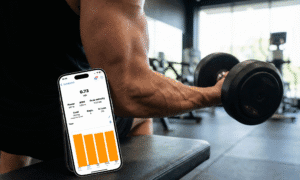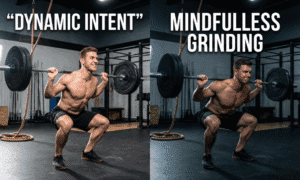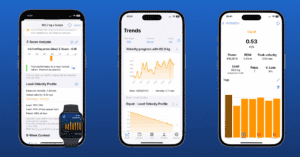Se você já viu um atleta se esforçando ao máximo em uma série que deveria ser "explosiva", sabe o que é essa frustração. O programa indicava 80% de 1RM. O atleta fez as contas. A barra se moveu como se estivesse presa em concreto. Algo claramente estava errado — mas o quê?
Eis a verdade incômoda que o treinamento tradicional baseado em porcentagens não quer que você ouça: A carga máxima (1RM) do seu atleta varia de 10 a 20%, dependendo do sono, estresse, nutrição e fadiga acumulada.¹. Aquela carga perfeitamente calculada de 80%? Pode ser, na verdade, 90% hoje — ou 70% amanhã. É exatamente por isso que os treinadores que entendem Como programar com VBT O treinamento baseado em velocidade está produzindo atletas que se adaptam mais rapidamente, permanecem mais saudáveis e têm um bom desempenho quando importa.
Vamos detalhar exatamente como implementar a programação baseada em velocidade em seus sistemas de treinamento, usando ferramentas como Aplicativo Spleft Medir e monitorar as métricas que realmente preveem o desempenho.
BAIXE O APLICATIVO SPLEEFT AGORA PARA iOS, ANDROID E APPLE WATCH!
O que diferencia a VBT da programação tradicional?
Os programas tradicionais de treinamento de força têm se baseado no modelo de porcentagem de 1RM desde a era soviética. Funciona — até certo ponto. Mas aqui está o problema: essa abordagem pressupõe que sua força máxima seja um número fixo que permanece constante entre as sessões de teste¹². Na realidade, o verdadeiro 1RM de um atleta pode variar drasticamente dependendo de sua prontidão diária.
O Treinamento Baseado em Velocidade inverte esse paradigma ao usar velocidade de movimento como principal indicador da intensidade do treino. Quanto mais rápido um atleta move uma determinada carga (com intenção máxima), mais leve essa carga é em relação à sua capacidade atual. A relação entre carga e velocidade é notavelmente consistente e linear entre indivíduos treinados²³.
A pesquisa fundamental de González-Badillo e Sánchez-Medina estabeleceu que a velocidade da barra se correlaciona fortemente com o %1RM em vários exercícios². Isso significa que você pode usar dados de velocidade para:
Estimativa de 1RM sem teste máximo
Prescreva cargas de treinamento com base no desempenho em tempo real.
Monitore instantaneamente a fadiga e o nível de prontidão.
Autorregular o volume durante uma sessão
É aí que entra um aplicativo como Aplicativo Spleft torna-se inestimável. Em vez de esperar que seus atletas estejam treinando na intensidade correta, você pode medir sua velocidade em tempo real e tomar decisões informadas no local.
Entendendo o Perfil Carga-Velocidade: Sua Nova Bússola de Treinamento
Antes de programar eficazmente com VBT, você precisa entender o perfil de carga-velocidade—a relação individualizada entre o peso na barra e a velocidade com que o atleta consegue movê-la.
Considere isso como a impressão digital do seu atleta para um determinado exercício. Quando representada em um gráfico, a relação forma uma linha quase linear: à medida que a carga aumenta, a velocidade diminui de forma previsível²⁴. Esse perfil permite que você:
Prever 1RM a partir de cargas submáximas — Não há necessidade de levar os atletas ao fracasso.
Identificar as características de força-velocidade — Seu atleta é dominante em força ou em velocidade?
Acompanhe o progresso ao longo do tempo. — Uma mudança no perfil indica adaptação.
Prescreva cargas com precisão. — Direcione zonas de velocidade específicas para as adaptações desejadas
Criando um perfil de carga-velocidade com o aplicativo Spleft
Para criar um perfil preciso, você precisará de dados de velocidade em 4 a 6 cargas, variando de leve (~40-50% 1RM) a pesada (~85-90% 1RM)⁵. Aqui está um protocolo prático:
Aqueça-se completamente. com o exercício alvo
Comece com a barra vazia ou com pouca carga. e execute de 3 a 5 repetições com a máxima intensidade.
Adicione peso progressivamente (10-15% saltos) e registre a melhor velocidade de repetição em cada carga.
Continue até que a velocidade caia abaixo de ~0,5 m/s. (para a maioria dos exercícios)
Represente os dados graficamente. para visualizar a relação carga-velocidade
O aplicativo Spleeft gera automaticamente esse perfil enquanto você treina, atualizando-o continuamente com base nos seus dados de desempenho recentes. O aplicativo usa seu histórico de dados de velocidade para estimar seu 1RM sem nunca exigir uma tentativa de carga máxima real — uma verdadeira revolução para gerenciamento de atletas prontidão para saúde e treinamento⁶.
O Limiar de Velocidade Mínima: Onde o Perfil Encontra a Realidade
Cada exercício tem um Limiar de Velocidade Mínima (MVT)—a velocidade mais lenta na qual uma repetição completa pode ser realizada. Essa é essencialmente a velocidade em 1RM². Compreender o MVT é fundamental para uma estimativa precisa de 1RM e para a seleção adequada da carga.
| Exercício | Limiar de velocidade mínima (m/s) | Notas |
|---|---|---|
| Agachamento | ~0.30 | Maior devido ao ciclo alongamento-encurtamento²⁷ |
| Supino | 0.15-0.17 | MVT mais baixo; ROM²⁷ limitado |
| Levantamento terra | 0.15-0.25 | Sem SSC; varia consideravelmente⁷ |
| Pressão aérea | ~0.19 | Entre os valores de agachamento e supino⁵ |
Quando o seu perfil de carga-velocidade se cruza com o MVT (Volume Máximo Viável), você encontra sua estimativa de 1RM (uma repetição máxima). O aplicativo Spleeft calcula isso automaticamente, fornecendo uma base de força confiável que se atualiza conforme o progresso do seu atleta.
Zonas de Velocidade: Programação para Adaptações Específicas
Uma das aplicações mais poderosas da VBT é a capacidade de segmentar. adaptações específicas de treinamento ao prescrever zonas de velocidade em vez de percentagens arbitrárias. Diferentes velocidades de movimento correspondem a diferentes exigências neuromusculares e, consequentemente, a diferentes resultados de treino⁸⁹.
| Zona de Treinamento | Faixa de velocidade (m/s) | Aproximadamente %1RM | Adaptação primária |
|---|---|---|---|
| Força Absoluta | < 0,50 | ≥ 80% | Força máxima, eficiência neural |
| Força Acelerativa | 0,50 – 0,75 | 65-80% | Produção de força, recrutamento de unidades motorizadas |
| Força-Velocidade | 0,75 – 1,00 | 50-65% | Potência de saída, força explosiva |
| Velocidade-Força | 1,00 – 1,30 | 35-50% | Taxa de desenvolvimento de força |
| Velocidade inicial | > 1,30 | < 35% | Capacidade de reação, poder balístico |
Como usar zonas de velocidade na prática
Digamos que você esteja trabalhando com um jogador de vôlei que precisa de melhorar o salto desempenho. A programação tradicional pode prescrever “5×5 @ 75%”—mas isso não lhe diz nada sobre o estímulo real do treinamento.
Utilizando zonas de velocidade com o aplicativo Spleeft, você pode programar:
Bloco de Desenvolvimento de Energia:
Agachamento: 4×3 a 0,75-0,90 m/s (zona de força-velocidade)
Salto na barra de armadilha: 4×3 @ >1,0 m/s (zona de velocidade-resistência)
O atleta aquece, encontra a carga que o coloca na zona de velocidade alvo e treina nessa faixa. Se estiver fatigado e a velocidade cair abaixo da zona, reduz-se a carga ou encerra-se a série. Se estiver descansado e a velocidade estiver muito alta, adiciona-se peso. A zona de velocidade garante a adaptação pretendida, independentemente das flutuações diárias na força absoluta.
Limiares de Perda de Velocidade: A Maneira Mais Inteligente de Gerenciar a Fadiga
Talvez nenhum conceito em programação VBT tenha gerado mais interesse de pesquisa do que perda de velocidade—a diminuição na velocidade da barra ao longo das repetições dentro de uma série. Essa métrica fornece uma visão em tempo real do acúmulo de fadiga e da proximidade da falha¹⁰¹¹.
A pesquisa pioneira de Pareja-Blanco e seus colegas demonstrou que a magnitude da perda de velocidade experimentada durante uma série é uma variável crítica que determina os resultados do treinamento¹⁰. Veja o que as evidências mostram:
| Perda de velocidade | Proximidade da Falha | Efeito primário | Nível de fadiga | Melhor para |
|---|---|---|---|---|
| 0-10% | Muito longe (5-8 RIR) | Adaptações neurais | Mínimo | Atletas de força, em temporada¹² |
| 10-20% | Longe (3-5 RIR) | ganhos de força | Baixo | Força geral¹⁰ |
| 20-30% | Moderado (2-3 RIR) | Equilibrado | Moderado | Força e hipertrofia¹³ |
| 30-40% | Fechar (1-2 RIR) | Hipertrofia | Alto | Fases de construção muscular¹⁴ |
| > 40% | Quase fracasso | Resistência | Muito alto | Resistência muscular¹⁴ |
A aplicação prática
Aqui é onde Como programar com VBT A coisa fica realmente empolgante. Em vez de prescrever um número fixo de repetições, você pode prescrever um limite de perda de velocidade e deixar que a prontidão diária do atleta determine o volume.
Exemplo de protocolo:
Exercício: Agachamento com barra nas costas
CarregarPrimeira repetição a aproximadamente 0,65 m/s
Limiar de Perda de Velocidade: 20%
Conjuntos: 4
O atleta realiza repetições até que a velocidade caia para aproximadamente 0,52 m/s (perda de 0,65 m/s no teste 20%), então interrompe a série. Em um bom dia, ele pode conseguir 6 repetições. Em um dia mais difícil, talvez 4. De qualquer forma, o estímulo de fadiga é equivalente—e esse é o ponto.
O aplicativo Spleeft facilita tudo, exibindo as zonas de perda de velocidade em tempo real. Você define seu limite e o aplicativo avisa quando parar. Chega de repetições exaustivas que fazem mais mal do que bem.
Quatro métodos de programação comprovados usando VBT
Agora vamos aos detalhes. Existem vários métodos baseados em evidências para Como programar com VBT, cada um com vantagens distintas dependendo do seu contexto e objetivos¹⁵.
Método 1: Baseado em porcentagem com feedback de velocidade
Este é o ponto de entrada mais acessível para o VBT. Os atletas seguem as prescrições tradicionais %1RM, mas recebem feedback de velocidade para melhorar a intenção e monitorar a prontidão¹⁵.
Exemplo: 4×5 @ 80% 1RM com rastreamento de velocidade
Vantagens:
Estrutura familiar para treinadores e atletas.
Os dados de velocidade revelam se as cargas são adequadas.
Constrói um banco de dados histórico para programação futura.
Quando usarApresentando o VBT a uma equipe, nas fases iniciais da pré-temporada ou quando você deseja dados de velocidade sem reformular seu sistema atual.
Método 2: Prescrição da Zona de Velocidade
Prescreva uma zona de velocidade alvo em vez de uma porcentagem. Os atletas aquecem para encontrar a carga que produz a velocidade desejada e treinam com essa carga¹⁵.
Exemplo: 4×3 a 0,50-0,65 m/s (zona de força de aceleração)
Vantagens:
Ajusta-se automaticamente à prontidão diária.
Garante um estímulo de treinamento preciso.
Elimina as suposições na seleção da carga.
Quando usarTreinamento específico para cada fase, quando o objetivo são adaptações particulares, ou com atletas que já possuem perfis de carga-velocidade estabelecidos.
Método 3: Limites de perda de velocidade
As séries terminam quando a velocidade cai em uma porcentagem predeterminada em relação à repetição mais rápida, controlando a fadiga e a qualidade da repetição¹⁰¹⁵.
Exemplo: 4 conjuntos a uma velocidade inicial de 0,55 m/s, corte de perda de velocidade 20%
Vantagens:
Regula automaticamente o volume com base na fadiga.
Impede o volume de lixo
Preserva a qualidade da repetição durante toda a sessão.
Quando usarTreinamento durante a temporada, fases de desenvolvimento de potência ou quando o gerenciamento da fadiga acumulada é crucial.
Método 4: Repetições indeterminadas dentro da faixa de velocidade (AMRAP)
Os atletas realizam o máximo de repetições possível, mantendo-se dentro de uma faixa de velocidade definida. A série termina quando a velocidade cai abaixo do limite inferior¹⁵.
Exemplo: AMRAP a 0,45-0,60 m/s
Vantagens:
Maximiza o volume efetivo
Autorregulação baseada na capacidade diária
Excelente para monitorar a capacidade de trabalho ao longo do tempo.
Quando usarFases gerais de preparação, desenvolvimento da capacidade de trabalho ou quando se deseja o máximo volume produtivo.
Implementando VBT com o aplicativo Spleeft: um fluxo de trabalho prático
Vamos analisar como um treinador pode implementar isso. Programação VBT Utilizando o aplicativo Spleeft ao longo de uma semana de treinamento.
Dia 1: Força e Potência da Parte Inferior do Corpo
ObjetivoDesenvolver qualidades de força e velocidade para melhorar a aceleração.
Abra o aplicativo Spleft e selecione o perfil do atleta.
Aquecimento para agachamento com barra nas costasCarregamento progressivo, registrando a velocidade em cada peso.
O aplicativo atualiza automaticamente o perfil de carga-velocidade.
Monitore a estimativa de 1RM exibida — se estiver abaixo do normal, o atleta pode precisar de ajustes de carga.
Conjuntos de Trabalho: 4×4 a 0,55-0,70 m/s com corte de perda de velocidade 15%
O Spleeft exibe a velocidade em tempo real e emite alertas quando o limite é atingido.
Se a velocidade se mantiver alta, considere adicionar 2,5 a 5 kg nas séries subsequentes.
Saltos na barra fixa: 4×3 a >1,0 m/s
Trabalho de força-velocidade pura; se a velocidade cair abaixo do alvo, reduza a carga imediatamente.
Dia 2: Força na parte superior do corpo
ObjetivoDesenvolva força de pressão com fadiga controlada.
Supino com Carga ProgressivaAumente a carga até atingir o peso ideal enquanto Spleeft monitora as velocidades.
Conjuntos de Trabalho: 5×3 a 0,35-0,50 m/s com limite de perda de velocidade 20%
O aplicativo mostra que você está na zona de força de aceleração.
O feedback de velocidade confirma que cada repetição está treinando a qualidade pretendida.
Revisão da SessãoConfira o resumo do aplicativo: total de repetições, velocidade média e tendências de perda de velocidade.
Compare com as sessões anteriores para monitorar o progresso.
Revisão Semanal
Ao final da semana, revise o painel de controle no aplicativo Spleeft:
Estimativas de 1RMEstão em tendência de alta?
Velocidades médias de treinamentoOs atletas estão mantendo a velocidade com cargas semelhantes?
Padrões de Perda de VelocidadeAlgum sinal de alerta indicando acúmulo de fadiga?
Essa abordagem baseada em dados transforma a programação de uma mera suposição fundamentada em algo concreto. treinamento de precisão—e esse é o verdadeiro poder da compreensão. Como programar com VBT.
Autorregulação e prontidão diária: a vantagem do VBT
Um dos aspectos mais valiosos da VBT é a sua capacidade de autorregulação—ajustando cargas e volumes de treinamento com base em indicadores de desempenho em tempo real¹⁶¹⁷.
Os programas tradicionais partem do princípio de que terça-feira será sempre um bom dia para agachamentos pesados. A realidade não é bem assim. Privação de sono, estresse psicológico, viagens e a vida fora da academia impactam o desempenho.
Pesquisas mostram que a velocidade é mais sensível a mudanças de prontidão do que a carga levantada ou a percepção subjetiva de esforço (PSE)¹⁷. Um atleta pode atingir os números prescritos em um dia de baixa prontidão, mas o esforço contínuo pode ser prejudicial. repetições lentas revelam que estão trabalhando muito mais do que o previsto.
Utilizando o aplicativo Spleft para monitoramento de prontidão
O aplicativo Spleeft compara a velocidade da sua sessão atual com a sua média histórica para a mesma carga. Veja como interpretar os dados:
Velocidade > 5% acima da médiaAlta disponibilidade — considere adicionar carga ou volume.
Velocidade dentro de 5% da médiaProntidão normal — prosseguir conforme planejado.
Velocidade 5-10% abaixo da médiaFadiga moderada — considere reduzir a carga em 5%.
Velocidade > 10% abaixo da médiaBaixa prontidão — reduza o volume e a intensidade, concentre-se na recuperação.
Não se trata de tratar os atletas como crianças. Trata-se de treinamento inteligente. O objetivo é a sobrecarga progressiva ao longo do tempo, e isso requer um gerenciamento estratégico da fadiga em sessões individuais e ao longo dos ciclos de treinamento.
5 erros comuns ao aprender a programar com VBT
Como em qualquer metodologia, existem armadilhas a evitar:
Erro 1: Obsessão pelos números de velocidade em vez da intenção
O VBT só funciona quando os atletas se movem com intenção máxima². Se eles estiverem controlando o ritmo ou não tentando acelerar a barra, os dados de velocidade não têm significado. A intenção do treinador vem em primeiro lugar, a velocidade da barra em segundo.
Erro 2: Definir metas de velocidade muito restritas
Uma meta de “exatamente 0,75 m/s” gera estresse desnecessário e paralisia decisória. Use intervalos (0,70-0,80 m/s) que explicam a variação natural de repetição para repetição.
Erro 3: Ignorar as diferenças individuais
Embora existam padrões de velocidade em grupo, atletas individuais podem apresentar perfis diferentes². Alguns naturalmente se movem mais rápido em todas as cargas; outros são mais resistentes. Elabore perfis individuais antes de tomar decisões sobre o programa de treinamento.
Erro 4: Negligenciar o protocolo de aquecimento
Rotinas de aquecimento consistentes reduzem a variabilidade da velocidade e tornam seus dados mais confiáveis⁶. Padronize sua abordagem.
Erro 5: Usar VBT sem contexto
Os dados de velocidade não substituem o conhecimento técnico — eles o aprimoram. Os números orientam as decisões; eles não as tomam por você.
Integrando a VBT em programas existentes
Você não precisa reformular tudo para se beneficiar da VBT. Aqui está uma abordagem gradual:
Fase 1Adicione o rastreamento de velocidade ao seu programa atual. Colete dados, crie perfis, aprenda com os números.
Fase 2Introduza a autorregulação baseada na velocidade. Utilize limiares de perda de velocidade para determinar quando as séries terminam.
Fase 3Comece a prescrever por zonas de velocidade para os exercícios principais. Mantenha o trabalho baseado em porcentagens para os exercícios acessórios.
Fase 4Integração completa do VBT. Todos os levantamentos primários são programados por velocidade, com dados históricos orientando as decisões de periodização.
O aplicativo Spleeft oferece suporte a todas as fases dessa jornada, desde o simples rastreamento de velocidade até análises sofisticadas. Perfil de carga-velocidade e estimativa de 1RM.
A argumentação baseada em pesquisas a favor do VBT (Vocabulário Baseado em Técnicas)
As evidências que apoiam a VBT continuam a aumentar:
Meta-análises mostram que a VBT melhora efetivamente força máxima (SMD = 0,76), resistência muscular (SMD = 1,19), desempenho de salto (SMD = 0,53), e **capacidade de corrida (SMD = -0,40)**¹⁸.
O feedback de velocidade durante o treinamento aumenta a potência máxima em aproximadamente 8-9% comparado com condições sem feedback¹⁹.
Limiares de perda de velocidade baixos (10-20%) produzem ganhos de resistência semelhantes ou maiores do que limiares altos, ao mesmo tempo que exigem 50% menos repetições¹⁰¹².
A VBT permite uma estimativa de 1RM mais segura, particularmente valiosa para atletas jovens e protocolos de retorno ao jogo²⁰.
Em resumo: o VBT não é apenas mais uma moda passageira no treinamento. É uma metodologia fundamentada na fisiologia do exercício e respaldada por um sólido conjunto de pesquisas revisadas por pares.
FAQs
Posso usar VBT sem equipamentos caros?
Com certeza. Embora dispositivos de medição de velocidade dedicados ofereçam alta precisão, aplicativos como Aplicativo Spleft Aproveite os sensores do seu smartphone e a integração com o Apple Watch para fornecer dados de velocidade confiáveis a um custo muito menor. Pesquisas mostram que sistemas baseados em smartphones podem alcançar correlações acima de r > 0,95 com o padrão ouro. transdutores lineares para diversas aplicações.
Quanto tempo leva para ver os resultados da programação VBT?
A maioria dos atletas percebe melhorias na qualidade do treino imediatamente — maior consistência nas repetições, seleção de carga mais adequada e feedback mais claro sobre o esforço. Os ganhos objetivos de força geralmente surgem dentro de 4 a 8 semanas de implementação consistente, de forma semelhante aos programas tradicionais, mas com melhor desempenho. gerenciamento de fadiga.
O VBT é adequado para iniciantes na musculação?
Sim, com algumas considerações. Iniciantes frequentemente carecem da coordenação motora necessária para demonstrar velocidades consistentes no início de sua trajetória de treinamento. Concentre-se primeiro em desenvolver a competência do movimento e, em seguida, introduza o monitoramento da velocidade à medida que a técnica se estabiliza. O VBT (Teste de Velocidade Baseado em Exercícios) pode, na verdade, ajudar os iniciantes a aprenderem os níveis de esforço adequados, fornecendo feedback objetivo sobre a qualidade de suas repetições.
Qual a diferença entre velocidade média e velocidade máxima?
Velocidade média é a velocidade média durante toda a fase concêntrica — esta é a métrica mais comumente usada e que melhor se correlaciona com a carga relativa. Velocidade de pico é a maior velocidade instantânea atingida durante a decolagem. A maioria das pesquisas e aplicações práticas se baseia na velocidade média ou na velocidade propulsiva média (que exclui a fase de desaceleração em decolagens não balísticas)².
Com que frequência devo repetir o teste de 1RM ao usar o VBT?
Uma das principais vantagens do VBT é que raramente é necessário realizar testes de 1RM. Seu perfil de carga-velocidade fornece uma estimativa continuamente atualizada com base em dados de treinamento submáximo. Reavaliações formais podem ocorrer a cada 8 a 12 semanas para fins de validação, mas a estimativa diária do aplicativo Spleeft mantém você informado sem a fadiga e o risco de lesões associados a tentativas máximas.
Iván de Lucas Rogero
Desempenho Físico MSC e CEO SpeeftApp
Dedicado a melhorar o desempenho atlético e o treinamento de ciclismo, combinando ciência e tecnologia para gerar resultados.
Referências
González-Badillo JJ, Sánchez-Medina L, Ribas-Serna J, Rodríguez-Rosell D. Rumo a um novo paradigma no treinamento de resistência por meio do monitoramento de velocidade: Uma narrativa crítica e desafiadora. Aberto Med Esportivo. 2022;8(1):118.
González-Badillo JJ, Sánchez-Medina L. Velocidade de movimento como medida de intensidade de carga no treinamento de resistência. Int J Sports Med. 2010;31(5):347-352.
Jovanović M, Flanagan EP. Aplicações pesquisadas do treinamento de força baseado na velocidade. J Aust Strength Cond. 2014;22(2):58-69.
Sánchez-Medina L, González-Badillo JJ, Pérez CE, Pallarés JG. Estimativa da carga relativa da velocidade da barra no exercício full back squat. Int J Sports Med. 2017;38(5):370-377.
Guia de Perfil de Carga-Velocidade. Output Sports. 2024.
Treinador VBT. Estimativa de 1RM com treinamento baseado em velocidade: um guia completo. 2024.
Lake J, Naworynsky D, Duncan F, Jackson M. Comparação de diferentes limiares de velocidade mínima para estabelecer 1RM no levantamento terra. Int J Sports Physiol Perform. 2017;12(10):1316-1323.
MeasureUp. Treinamento baseado em velocidade para ganho de força: uma visão geral baseada em evidências. 2025.
Mann JB. Zonas de treinamento baseadas em velocidade e suas aplicações. GymAware. 2025.
Pareja-Blanco F, Rodríguez-Rosell D, Sánchez-Medina L, et al. Efeitos da perda de velocidade durante o treinamento de resistência no desempenho atlético, ganhos de força e adaptações musculares. Scand J Med Sci Sports. 2017;27(7):724-735.
Suchomel TJ, Nimphius S, Bellon CR, Stone MH. A importância da força muscular: considerações de treinamento. Sports Med. 2018;48(4):765-785.
Rodríguez-Rosell D, Yáñez-García JM, Torres-Torrelo J, et al. Treinamento de resistência baseado na velocidade: impacto da perda de velocidade na série sobre o desempenho neuromuscular e a resposta hormonal. Appl Physiol Nutr Metab. 2020;45(8):817-828.
Held S, Hecksteden A, Meyer T, Donath L. A eficácia do treinamento de força tradicional versus baseado em velocidade no desempenho de força explosiva e máxima: uma metanálise em rede. Front Physiol. 2022;13:926972.
Pareja-Blanco F, Alcazar J, Sánchez-Valdepeñas J, et al. Efeitos da perda de velocidade no exercício de supino sobre os ganhos de força, adaptações neuromusculares e hipertrofia muscular. Scand J Med Sci Sports. 2020;30(11):2154-2166.
Output Sports. Como programar com treinamento baseado em velocidade (VBT). 2024.
Greig L, Hemingway BHS, Aspe RR, et al. Autorregulação no treinamento de resistência: abordando as inconsistências. Sports Med. 2020;50(11):1873-1887.
Treinador VBT. Autorregulação e prontidão com treinamento baseado em velocidade. 2024.
Chen YS, Wang YT, Lin CY, et al. O papel do treinamento baseado em velocidade (TBV) na melhoria do desempenho atlético em indivíduos treinados: uma meta-análise de ensaios controlados. Int J Environ Res Public Health. 2022;19(15):9252.
Randell AD, Cronin JB, Keogh JW, et al. Efeito do feedback instantâneo de desempenho durante 6 semanas de treinamento de resistência baseado em velocidade em testes de desempenho específicos do esporte. J Strength Cond Res. 2011;25(1):87-93.
Weakley J, Mann B, Banyard H, et al. Treinamento baseado em velocidade: da teoria à aplicação. Strength Cond J. 2021;43(2):31-49.





